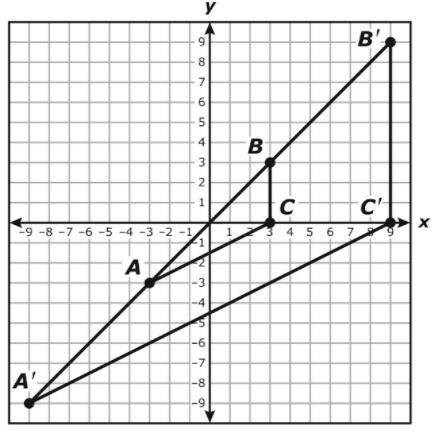
Mathematics, 25.02.2021 22:50 jazzzzhands21
Triangle ABC was dilated with the origin as the center of dilation to create triangle A'B'C'. Which statement about triangle A'B'C' appears to be true?
A: The side lengths of triangle A’B’C’ are each
the corresponding side lengths of triangle ABC, and the angle measures of triangle A’B’C’ are the same as the measures of the corresponding angles of triangle ABC.
B: The side lengths of triangle A’B’C’ are each 3 times the corresponding side lengths of triangle ABC, and the angle measures of triangle A’B’C’ are 3 times the measure of the corresponding angles of triangle ABC.
C: The side lengths of triangle A’B’C’ are each
the corresponding side lengths of triangle ABC, and the angle measures of triangle A’B’C’ are
the measure of the corresponding angles of triangle ABC.
D: The side lengths of triangle A’B’C’ are each 3 times the corresponding side lengths of triangle ABC, and the angle measures of triangle A’B’C’ are the same as the measures of the corresponding angles of triangle ABC.


Answers: 2


Other questions on the subject: Mathematics




Mathematics, 21.06.2019 21:30, gonzalezashley152
In a test for esp (extrasensory perception), the experimenter looks at cards that are hidden from the subject. each card contains either a star, a circle, a wave, a cross or a square.(five shapes) as the experimenter looks at each of 20 cards in turn, the subject names the shape on the card. when the esp study described above discovers a subject whose performance appears to be better than guessing, the study continues at greater length. the experimenter looks at many cards bearing one of five shapes (star, square, circle, wave, and cross) in an order determined by random numbers. the subject cannot see the experimenter as he looks at each card in turn, in order to avoid any possible nonverbal clues. the answers of a subject who does not have esp should be independent observations, each with probability 1/5 of success. we record 1000 attempts. which of the following assumptions must be met in order to solve this problem? it's reasonable to assume normality 0.8(1000), 0.2(1000)%30 approximately normal 0.8(1000), 0.2(1000)% 10 approximately normal srs it is reasonable to assume the total number of cards is over 10,000 it is reasonable to assume the total number of cards is over 1000
Answers: 1
You know the right answer?
Triangle ABC was dilated with the origin as the center of dilation to create triangle A'B'C'. Which...
Questions in other subjects:












